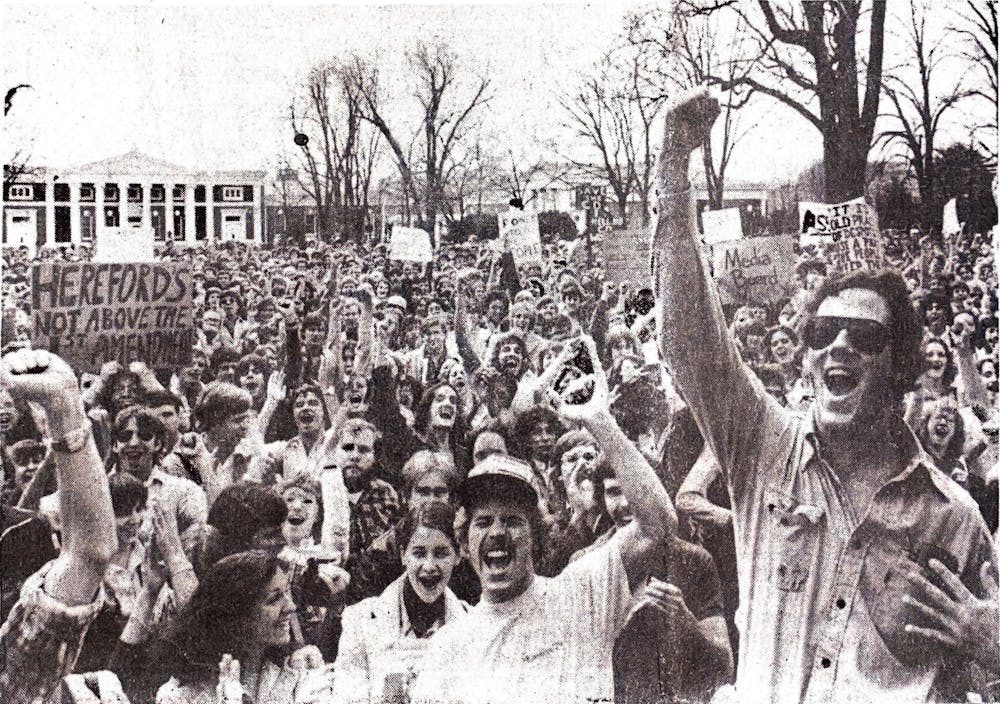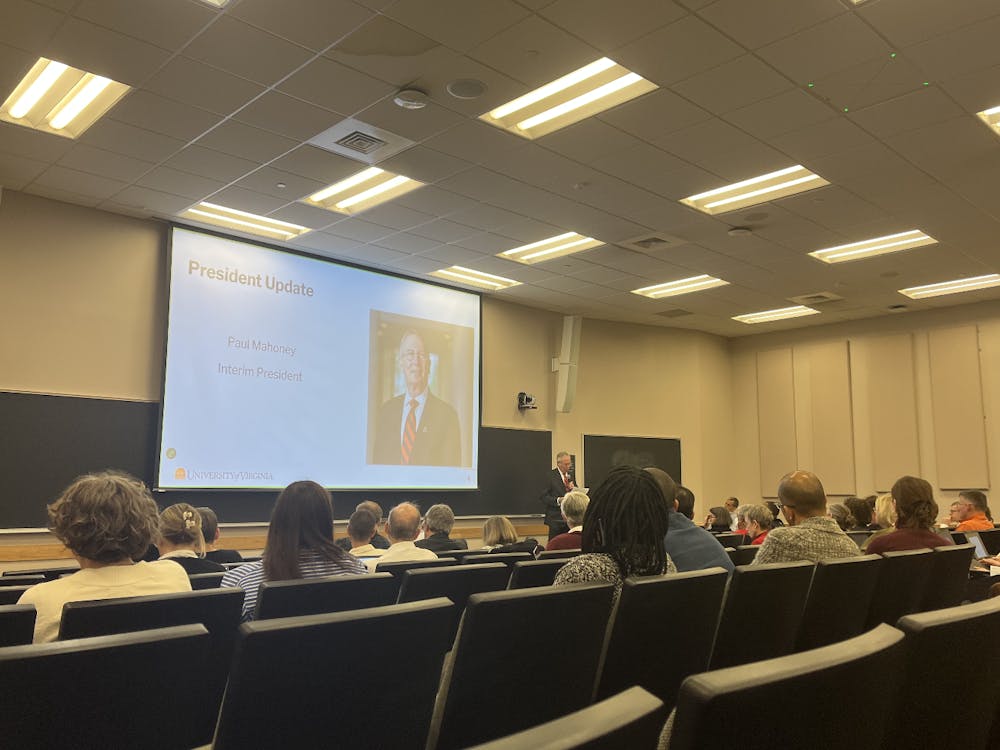After a controversy regarding editorial oversight of the paper caused The Cavalier Daily to disaffiliate from the University, newspaper alumni continue to stress the importance of the paper’s independent reporting 45 years after the split. The disaffiliation was sparked by the newspaper’s long-term refusal to acknowledge the authority of the University’s Media Board of Directors, which was tasked with overseeing student publications, and codified The Cavalier Daily’s financial and editorial independence.
The move to add a media board came after former University President Frank Hereford resigned from the racially-exclusive Farmington Country Club that February. Hereford’s membership in the club, which was covered by The Cavalier Daily, had been criticized by members of the University community as antithetical to the University’s ongoing mission to recruit more Black students and faculty. In the wake of this controversy, the Board of Visitors, which is comprised of representatives elected by the Virginia governor and determines many budget and policy changes at the University, approved Hereford’s proposal to create the Media Board of Directors in a resolution passed March 26, 1976.
According to the terms of the resolution, the student-run Media Board was tasked with the “authority and responsibility” of overseeing all student-operated publications that received support from the University, whether in the form of funding or the provision of office space and equipment. Following the creation of the Media Board in 1976, The Cavalier Daily would remain affiliated with the University for another three years.
Michael Vitez, editor-in-chief of The Cavalier Daily’s 1978-79 term and Class of 1979 alumnus, said that while the University provided the newspaper with its office space in Newcomb Hall, the publication was otherwise financially and editorially independent at the time the University created the Media Board.
“We in our hearts and minds completely believed that we were independent,” Vitez said. “We felt that we were protected by and operated under the First Amendment, and that we were a fiercely independent newspaper that believed strongly in reporting without any fear or favor.”
According to Richard F. Neel, Jr., editor-in-chief of The Cavalier Daily’s 1979-80 term and Class of 1980 alumnus, the newspaper’s belief in its independence led its editors to ignore the Media Board’s oversight. He said the paper refused to publish any letters of censure from the Media Board, which would be sent when the oversight board voted to condemn an editorial decision of The Cavalier Daily. Moreover, while the Media Board offered one seat for The Cavalier Daily at its meetings, the newspaper declined to send a representative, according to Neel.
After years of tension between the Media Board and The Cavalier Daily, the Board of Visitors approved a resolution directing Hereford to withdraw University funding and office space from The Cavalier Daily should they continue to refuse to acknowledge the authority of the Media Board. This resolution was passed at a Board meeting March 31, 1979, which was held privately as was standard at the time. Neel said a student leader who had been present at the Board meeting informed him the same day, giving him advance notice of the decision.
According to Neel, who had begun his term as editor-in-chief only days prior, Hereford summoned the paper’s new managing board to his office April 2 and gave them an ultimatum — acknowledge the authority of the Board of Visitors and the Media Board, or lose all University support for the newspaper. After the managing board confirmed that it did not recognize the Media Board’s authority, Hereford sent a letter to Neel April 3, 1979, officially withdrawing The Cavalier Daily’s permission to use University space and equipment. Following Hereford’s notice, The Cavalier Daily temporarily moved their operations to the facilities of The Daily Progress, where they continued to publish in the following days.
“It was a tense time,” Neel said. “[We worked] day to day just trying to get the newspaper out.”
The story of The Cavalier Daily’s eviction quickly garnered national attention, with The Washington Post reporting on the story and the Virginia chapter of the American Civil Liberties Union offering to assist the newspaper with legal representation. Neel noted that a number of alumni of The Cavalier Daily also stepped in and helped the managing board secure a competent legal team. Public pressure on the University culminated in a April 5, 1979 rally on the Lawn, which consisted of approximately 1,500 students and where attendees demanded the reinstatement of the newspaper to its office space in Newcomb Hall.
“Not [all students] necessarily would agree with us on everything, but they certainly agreed that we should be an independent voice,” Vitez said. “Certainly enough people that [it] made a difference.”
Amidst the backdrop of the protest, negotiations were underway between Hereford and the managing board. The same day as the protest, Neel and his fellow editors wrote a letter to Hereford agreeing to acknowledge the oversight of the Media Board, but only on the condition that the University enter into “good-faith negotiations” with The Cavalier Daily in order to achieve full independence for the newspaper. Avery Caitlin, former University executive vice president, was serving as acting president while Hereford was traveling and agreed to the negotiations on his behalf. The Cavalier Daily returned to its Newcomb Hall office space shortly after the protests.
According to Neel, the events of the Media Board crisis led him to work with other alumni to form the Cavalier Daily Alumni Association, which is designed to support current newspaper staffers professionally and technically.
Charlie Tyson, executive editor of The Cavalier Daily’s 2013-14 term and Class of 2014 alumnus, said that the newspaper's reporting helps ensure the transparency of the University administration. Tyson, who covered former University President Teresa Sullivan’s resignation and subsequent reinstatement by the Board of Visitors in 2012, said The Cavalier Daily’s reporting on the story provided the public with valuable information at a time when the Board was releasing few details about the reasoning behind their decisions.
“The reporting gave more substance to the people who were criticizing the Board’s decision,” Tyson said. “We weren’t there in the room when the Sullivan resignation was requested, but we did help shed what light we could on what was happening behind the scenes at a time when the Board was being very tight-lipped about what they were doing.”
Alexis Gravely, CDAA President and Class of 2019 alumna, also said that the paper’s continued editorial independence has allowed it to cover controversial stories more freely than it would be able to if affiliated with the University. She said that a legal case sparked by a 2014 article from Rolling Stone magazine, titled “A Rape on Campus,” was one such example. The article, which has since been retracted due to factual inaccuracies, focused on a student named Jackie Coakley who alleged that she had been sexually assaulted at a fraternity party.
“We had reporters in the courtroom every day covering that defamation case,” Gravely said. “I think that if we had not been editorially independent, U.Va. would not [have wanted] us to report on [stories like the Rolling Stone incident] as closely as we did.”
Beyond her time on staff at The Cavalier Daily, Gravely said serving as president of the CDAA has given her a new perspective on the newspaper and made her more familiar with the challenges of operating a student newspaper, which include providing funding for equipment and office space. Nonetheless, according to Gravely, these are difficulties well worth facing.
“If we have to have tight budgets or figure out how we’re going to do some sort of initiative or where we’re going to get new equipment … it would be easier if U.Va. would just give that stuff to us,” Gravely said. “But it would compromise the work that The Cavalier Daily does [that] is so valued by the U.Va. and Charlottesville community.”
Eva Surovell, editor-in-chief of The Cavalier Daily’s 2022 term and Class of 2023 alumna, also reflected on the importance of the newspaper’s independence as a way to hold the University accountable. Surovell cited the COVID-19 pandemic as an example, when the newspaper reported on the University administration’s handling of public safety. She recalled regularly logging on to Zoom meetings with University President Jim Ryan, Liz Magill, former vice president and provost, and Jennifer Davis, executive vice president and chief operating officer, to ask questions about the University’s most recent pandemic-related policy decisions.
“A lot of our job was holding U.Va. responsible for the way that they handled [the COVID-19 pandemic], and I really don’t think we could have done the job that we did without being independent and having that sort of distance,” Surovell said.
Surovell also said that in the years since it became independent, The Cavalier Daily has developed a respectful, albeit fluctuating, working relationship with the University.
“I think we’re really blessed today, and since [independence], to have developed a sort of working relationship with the University where they realize that we’re not going anywhere, [and] that we also are going to hold them accountable,” Surovell said. “That [relationship] where we recognize that sometimes we disagree, but that we all just ultimately want what’s best for the University and the University community, I would hope that can continue.”







